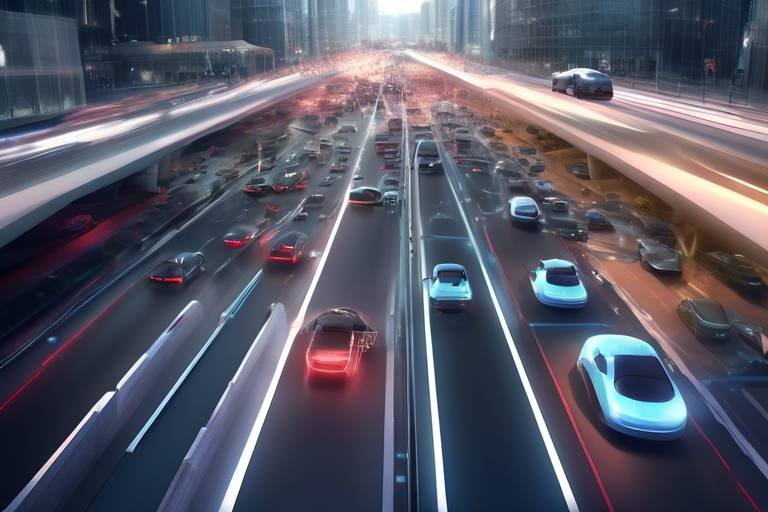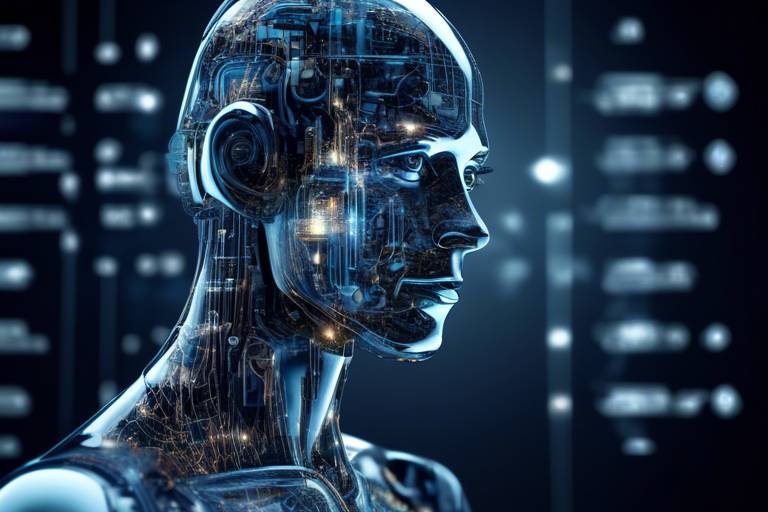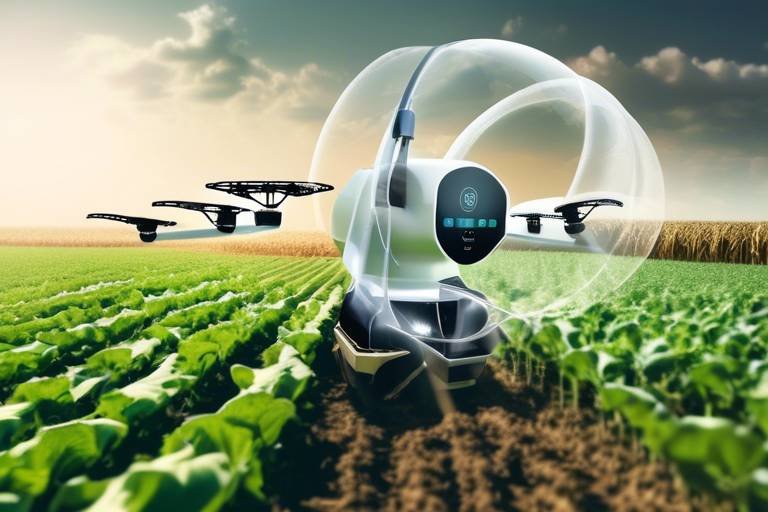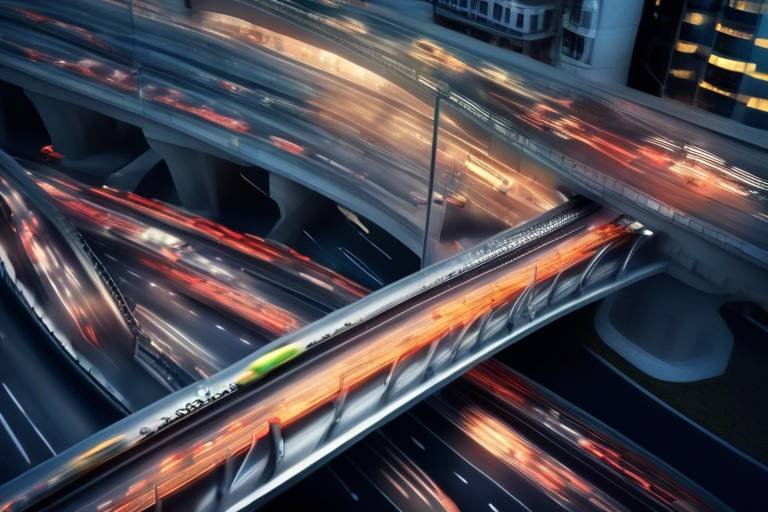The Future of Intelligent Transportation Systems
Welcome to the dawn of a new era in urban mobility! The Future of Intelligent Transportation Systems (ITS) is not just a buzzword; it's a transformative journey that aims to redefine how we navigate our cities. Picture this: a world where traffic jams are a thing of the past, accidents are minimized, and public transportation runs like a well-oiled machine. Sounds like a dream, right? Well, with the rapid advancements in technology, this dream is quickly becoming a reality.
Intelligent Transportation Systems leverage cutting-edge technologies, such as artificial intelligence (AI), real-time data analytics, and smart traffic management, to create a seamless flow of information between vehicles, infrastructure, and users. Imagine being able to receive live updates about traffic conditions, weather alerts, and even the availability of public transportation—all at your fingertips! This interconnectedness not only enhances the efficiency of our transportation networks but also significantly improves the overall user experience.
As we delve deeper into this exciting topic, we'll explore the current trends shaping ITS, the impact of autonomous vehicles, and the innovations in public transportation that are leading us toward a smarter future. But before we get ahead of ourselves, let’s take a moment to appreciate the profound implications of these systems on our daily lives. The integration of ITS into urban environments promises to enhance mobility, boost economic growth, and ultimately create safer, more sustainable cities.
So, what does the future hold? With every passing day, we inch closer to a reality where our roads are safer, our commutes are shorter, and our cities are more connected. The journey is just beginning, and the possibilities are endless. Buckle up as we explore the fascinating world of Intelligent Transportation Systems!
As we navigate through the current landscape of Intelligent Transportation Systems, it's essential to identify the key trends that are driving this revolution. From smart traffic management systems that adapt to real-time conditions to the integration of AI that optimizes transportation efficiency, the advancements are both impressive and crucial.
One of the most significant trends is the use of real-time data analytics. This technology allows cities to collect and analyze data from various sources, including traffic cameras, sensors, and GPS devices, to make informed decisions. By analyzing this data, cities can adjust traffic signals, manage congestion, and improve overall traffic flow. It's like having a traffic conductor who orchestrates the movement of vehicles, ensuring a harmonious flow on the roads.
Moreover, the rise of smart traffic management systems is transforming the way we approach urban mobility. These systems not only monitor traffic patterns but also predict future conditions. For instance, if a major event is happening in the city, the system can proactively adjust traffic signals to accommodate the expected influx of vehicles. This level of foresight is a game-changer when it comes to reducing congestion and enhancing the efficiency of our transportation networks.
Now, let's shift gears and talk about one of the most exciting developments in the world of transportation: autonomous vehicles. These self-driving wonders are not just futuristic fantasies; they are set to revolutionize our transportation systems in ways we never thought possible. Imagine hopping into a car that drives you to your destination while you enjoy your favorite podcast or catch up on emails. Sounds convenient, right?
But the benefits of autonomous vehicles extend far beyond convenience. They have the potential to significantly improve road safety by reducing human error, which is responsible for a staggering percentage of traffic accidents. With advanced sensors and AI algorithms, these vehicles can detect obstacles, respond to sudden changes in traffic, and communicate with other vehicles to prevent collisions. It's like having a vigilant co-pilot who never gets distracted!
However, the integration of autonomous vehicles into our existing infrastructure does pose challenges. We need to ensure our roads and traffic systems can accommodate these vehicles, which may require significant upgrades. Additionally, public acceptance and trust in this technology will be crucial for its widespread adoption. After all, who wouldn't want to ride in a car that promises to keep them safe?
Safety is paramount in transportation, and Intelligent Transportation Systems play a pivotal role in enhancing safety measures. With the incorporation of advanced technologies, ITS can significantly reduce accidents and improve emergency response times. For instance, smart traffic signals can prioritize emergency vehicles, ensuring they reach their destinations swiftly.
Furthermore, the concept of Vehicle-to-Everything (V2X) communication is gaining traction. This technology allows vehicles to communicate with each other, as well as with traffic infrastructure, pedestrians, and even cyclists. By sharing real-time information, V2X can enhance situational awareness and drastically reduce the likelihood of collisions. It's like giving vehicles a sixth sense!
With the rise of connectivity and data sharing in Intelligent Transportation Systems, concerns around data privacy are becoming increasingly prominent. As vehicles collect and transmit vast amounts of data, it's crucial to address how this information is used and protected. Striking a balance between leveraging data for improved transportation efficiency and ensuring user privacy is essential.
Robust privacy measures must be implemented to safeguard personal information while fostering innovation in ITS. Transparency in data collection practices and user consent will be key to building trust among users and ensuring the successful adoption of these technologies.
Innovations in public transportation are vital for enhancing urban mobility. Intelligent Transportation Systems are revolutionizing public transit by improving efficiency, user experience, and integration with other modes of transportation. Imagine a world where buses arrive on time, routes are optimized based on real-time demand, and passengers receive live updates about their journeys.
Incorporating technology into public transit not only makes it more reliable but also encourages more people to use these services, ultimately reducing congestion and pollution in our cities. With ITS, public transportation can become the backbone of urban mobility, seamlessly connecting various modes of travel and making it easier for people to get around.
Despite the numerous benefits of Intelligent Transportation Systems, implementing these technologies is not without its challenges. Issues such as funding, technological barriers, and public acceptance present significant hurdles that need to be addressed.
For instance, the successful deployment of ITS relies heavily on adequate infrastructure. Upgrading existing roads, traffic signals, and communication networks will require substantial investment. It's like renovating an old house; you need to ensure the foundation is strong before adding modern amenities.
To support advanced transportation technologies, cities must invest in the necessary infrastructure. This includes upgrading roads, installing smart traffic signals, and implementing data collection systems. Without these upgrades, the full potential of Intelligent Transportation Systems cannot be realized.
Effective regulation is essential for the development of Intelligent Transportation Systems. Existing policies need to be analyzed and updated to facilitate innovation while ensuring safety and equity in transportation systems. A robust regulatory framework will help guide the implementation of ITS, ensuring that these technologies are used responsibly and effectively.
- What are Intelligent Transportation Systems?
ITS refers to advanced technologies that enhance transportation efficiency, safety, and user experience. - How do autonomous vehicles improve safety?
Autonomous vehicles utilize advanced sensors and AI to reduce human error, which is a leading cause of traffic accidents. - What is V2X communication?
V2X communication allows vehicles to communicate with each other and their environment to enhance situational awareness. - What are the main challenges in implementing ITS?
Key challenges include funding, technological barriers, and public acceptance of new technologies.

Current Trends in Intelligent Transportation
As we stand on the brink of a transportation revolution, the advancements in Intelligent Transportation Systems (ITS) are nothing short of remarkable. These systems are designed not just to manage traffic but to fundamentally reshape how we think about mobility in urban environments. With the integration of cutting-edge technologies, we are witnessing a transformation that promises to enhance efficiency, improve safety, and elevate the overall user experience.
One of the most significant trends in ITS is the implementation of smart traffic management systems. These systems utilize real-time data analytics to monitor traffic flow, detect congestion, and optimize signal timings. Imagine a world where traffic lights adapt to the flow of vehicles, reducing wait times and minimizing emissions. This is not just a dream; it’s becoming a reality in cities around the globe. For instance, cities like San Francisco and Los Angeles are already employing intelligent traffic signals that communicate with vehicles, adjusting their timings based on real-time conditions.
Moreover, the integration of Artificial Intelligence (AI) into transportation systems is enhancing the efficiency of public transit. AI algorithms analyze vast amounts of data to predict ridership trends, enabling transit authorities to allocate resources more effectively. This results in fewer crowded buses and trains, making public transportation a more appealing option for daily commuters. The use of AI also extends to personalized travel recommendations, helping users choose the best routes and modes of transport based on their preferences and real-time conditions.
Another exciting trend is the rise of connected vehicles. These vehicles are equipped with various sensors and communication technologies that allow them to share information with each other and with the surrounding infrastructure. This connectivity not only improves situational awareness for drivers but also enhances the overall safety of the transportation system. For example, if a vehicle detects sudden braking ahead, it can immediately alert other vehicles in the vicinity, reducing the likelihood of collisions.
However, with these advancements come challenges. The collection and sharing of data raise significant privacy concerns. As vehicles become more connected, the amount of data generated is staggering. This data can be incredibly valuable for improving transportation systems, but it also poses risks if not managed properly. Ensuring that personal data is protected while still harnessing the benefits of data analytics is a critical challenge that needs to be addressed.
In conclusion, the trends in intelligent transportation systems are paving the way for a future where mobility is not just about getting from point A to point B but doing so in an efficient, safe, and user-friendly manner. As cities continue to adopt these technologies, we can expect to see a significant shift in how we navigate our urban landscapes, making our commutes smoother and our cities more livable.
- What are Intelligent Transportation Systems?
Intelligent Transportation Systems (ITS) are advanced applications that aim to provide innovative services relating to different modes of transport and traffic management. They utilize various technologies to improve safety, efficiency, and user experience. - How does smart traffic management work?
Smart traffic management systems use real-time data analytics to monitor traffic conditions and adjust traffic signals dynamically, improving traffic flow and reducing congestion. - What role does AI play in public transportation?
AI enhances public transportation by analyzing data to predict ridership patterns, optimize routes, and improve the overall user experience. - What are the privacy concerns associated with connected vehicles?
The primary concern is the potential misuse of personal data collected by connected vehicles. Ensuring robust data privacy measures is crucial to protect users' information.

Impact of Autonomous Vehicles
Autonomous vehicles (AVs) are not just a futuristic dream; they are rapidly becoming a reality that is set to revolutionize our transportation systems. Imagine a world where cars drive themselves, reducing the stress of commuting and allowing you to catch up on your favorite show or read a book during your daily drive. This shift is not just about convenience; it has profound implications for mobility, efficiency, and safety in urban environments.
One of the most significant benefits of autonomous vehicles is their potential to enhance road safety. With advanced sensors and artificial intelligence, AVs can react to their surroundings in milliseconds, significantly reducing the likelihood of accidents caused by human error. According to studies, human errors account for approximately 94% of all traffic accidents. By minimizing the human factor, AVs could potentially save thousands of lives each year.
However, the integration of autonomous vehicles into existing transportation systems is not without its challenges. For instance, how do we ensure that these vehicles communicate effectively with traditional vehicles and infrastructure? This is where the concept of Vehicle-to-Everything (V2X) communication comes into play. V2X technology allows vehicles to communicate with each other, traffic lights, and even pedestrians, creating a network that enhances situational awareness and helps prevent collisions.
Moreover, AVs can help alleviate traffic congestion in urban areas. By utilizing real-time data analytics, these vehicles can optimize their routes based on current traffic conditions, reducing travel times and fuel consumption. Imagine a city where traffic jams are a thing of the past, and getting from point A to point B is a seamless experience. This could lead to a significant reduction in greenhouse gas emissions, contributing to a more sustainable future.
Despite these promising benefits, the road to widespread adoption of autonomous vehicles is fraught with challenges. Public acceptance is perhaps one of the most significant hurdles. Many people are still skeptical about the safety and reliability of AVs. To address these concerns, it is crucial to engage in educational campaigns that inform the public about the technology and its benefits. Additionally, manufacturers must demonstrate the safety of their vehicles through rigorous testing and transparent reporting.
Furthermore, the existing infrastructure may require significant upgrades to accommodate AVs. For instance, cities may need to invest in smart traffic signals and dedicated lanes for autonomous vehicles to ensure smooth integration into the current transportation ecosystem. This necessitates a collaborative effort between government agencies, private companies, and communities to create a supportive infrastructure that fosters innovation.
To summarize, the impact of autonomous vehicles on our transportation systems is profound. They promise to enhance safety, reduce traffic congestion, and improve mobility. However, realizing this potential will require overcoming significant challenges, including public acceptance and infrastructure readiness. As we move forward, it is essential to foster an environment that encourages innovation while addressing the concerns of all stakeholders involved.
- What are autonomous vehicles? Autonomous vehicles are cars or trucks that are capable of navigating and driving themselves without human intervention.
- How do autonomous vehicles improve safety? They utilize advanced sensors and AI to detect and respond to their environment, significantly reducing the risk of accidents caused by human error.
- What is V2X communication? Vehicle-to-Everything (V2X) communication is a technology that allows vehicles to communicate with each other and with infrastructure, enhancing situational awareness.
- What challenges do autonomous vehicles face? Major challenges include public acceptance, infrastructure requirements, and regulatory hurdles.

Safety Enhancements
When it comes to transportation, safety is the name of the game. Imagine a world where traffic accidents are reduced to a minimum, where emergency vehicles can reach their destinations without delay, and where drivers are equipped with real-time information to make safer decisions. This is the vision that intelligent transportation systems (ITS) are bringing to life. By leveraging cutting-edge technologies, ITS is transforming how we think about road safety.
One of the most significant advancements in safety enhancements comes from the integration of real-time data analytics. Traffic signals can now adapt dynamically based on current traffic conditions, which helps in alleviating congestion and reducing the likelihood of accidents. For instance, if a traffic jam is detected, the system can automatically adjust signal timings to facilitate smoother flow, preventing the kind of stop-and-go traffic that often leads to collisions.
Moreover, the deployment of advanced driver-assistance systems (ADAS) is a game changer. These systems utilize a variety of sensors, cameras, and radar to provide drivers with crucial information about their surroundings. Features such as lane-keeping assistance, adaptive cruise control, and automatic emergency braking are becoming standard in many vehicles. These technologies not only assist drivers but also work to prevent accidents before they happen.
Another key aspect of safety enhancements is the improvement in emergency response times. Intelligent transportation systems can prioritize emergency vehicles by communicating with traffic signals to create clear pathways. This means that ambulances, fire trucks, and police cars can navigate through congested streets more efficiently. A study conducted in major cities showed that implementing these systems reduced emergency response times by up to 20%. When every second counts, these enhancements can mean the difference between life and death.
Furthermore, the concept of Vehicle-to-Everything (V2X) communication plays a pivotal role in enhancing safety. This technology allows vehicles to communicate with each other and with infrastructure elements like traffic lights and road signs. For example, if a vehicle detects a potential hazard, it can send alerts to nearby vehicles, warning them of the danger ahead. This kind of communication creates a network of awareness that significantly reduces the risk of accidents.
However, with great power comes great responsibility. As we embrace these innovations, we must also address the data privacy concerns that arise from increased connectivity. The collection and sharing of data are essential for the functionality of ITS, but it is crucial to implement robust privacy measures to protect users. Striking the right balance between safety and privacy will be a challenge that stakeholders must navigate carefully.
In conclusion, the safety enhancements brought about by intelligent transportation systems are not just about reducing accidents; they are about creating a safer, more efficient urban environment. By integrating advanced technologies and fostering communication among vehicles and infrastructure, ITS is paving the way for a future where safety is prioritized on our roads. As we continue to innovate, the focus must remain on ensuring that these systems are accessible, effective, and respectful of individual privacy.
- What are intelligent transportation systems?
Intelligent transportation systems (ITS) use technology to improve transportation safety, efficiency, and mobility by integrating data collection, analysis, and communication. - How do ITS improve road safety?
ITS enhance road safety through real-time data analytics, advanced driver-assistance systems, and vehicle-to-everything communication, which help prevent accidents and improve emergency response times. - What role do autonomous vehicles play in ITS?
Autonomous vehicles rely on ITS for navigation, communication, and real-time data to enhance safety and efficiency in urban environments. - Are there privacy concerns with ITS?
Yes, the collection and sharing of data in ITS raise privacy concerns, making it essential to implement strong data protection measures.

Vehicle-to-Everything Communication
Vehicle-to-Everything (V2X) communication is a groundbreaking technology that enables vehicles to interact not only with each other but also with the surrounding infrastructure, pedestrians, and even the cloud. Imagine a world where your car can communicate with traffic lights to optimize your route or warn you about potential hazards ahead. This is not science fiction; it's the future of transportation, and it's already underway. The essence of V2X lies in its ability to create a network of communication that enhances situational awareness and ultimately contributes to safer roads.
At its core, V2X communication can be divided into several components:
- Vehicle-to-Vehicle (V2V): This allows cars to share information with one another, such as speed, direction, and braking status. By doing so, vehicles can anticipate each other's movements, significantly reducing the chances of collisions.
- Vehicle-to-Infrastructure (V2I): This aspect involves communication between vehicles and road infrastructure, like traffic signals and road signs. For example, a vehicle can receive real-time information about traffic conditions or upcoming roadwork, allowing drivers to make informed decisions.
- Vehicle-to-Pedestrian (V2P): This feature aims to improve safety for pedestrians by allowing vehicles to communicate with mobile devices carried by people. Imagine a scenario where your phone alerts you that a car is approaching, enhancing your awareness and safety.
- Vehicle-to-Cloud (V2C): This allows vehicles to connect to cloud services for data analytics and updates, providing insights into traffic patterns and vehicle performance.
The benefits of V2X communication are immense. For instance, it can lead to a significant reduction in traffic congestion by enabling vehicles to adjust their speeds based on real-time traffic data. This not only saves time but also reduces fuel consumption and emissions. Furthermore, V2X can enhance emergency response times by allowing emergency vehicles to communicate their location and route to other vehicles, clearing the way more efficiently.
However, the implementation of V2X communication is not without its challenges. One major concern is data privacy. With vehicles constantly communicating and sharing data, there is a risk of sensitive information being exposed. This raises questions about how data is collected, stored, and used. Strong regulations and security measures need to be put in place to protect users' privacy while still reaping the benefits of this technology.
In conclusion, Vehicle-to-Everything communication represents a significant leap forward in the evolution of intelligent transportation systems. By fostering a connected environment, V2X not only enhances safety and efficiency but also paves the way for a more sustainable future. As we continue to develop and integrate these technologies, the vision of smart cities and seamless mobility becomes more attainable.

Data Privacy Concerns
As we dive deeper into the realm of Intelligent Transportation Systems (ITS), one of the most pressing issues that emerges is data privacy. With the integration of advanced technologies and connectivity, vehicles and infrastructure are collecting and sharing vast amounts of data. This data can include everything from a driver's location to their driving habits, and while this information can significantly enhance efficiency and safety, it also raises some serious concerns.
Imagine driving down a busy street, and your vehicle is constantly communicating with traffic lights, other vehicles, and even pedestrians. While this connectivity can improve traffic flow and reduce accidents, it also means that your personal data is being shared and analyzed in real-time. The question arises: who owns this data, and how is it being used?
Many individuals are understandably uneasy about the potential misuse of their personal information. For instance, if a hacker gains access to a transportation network, they could potentially manipulate data to cause chaos. Furthermore, companies that collect this data may not always have the best intentions, leading to concerns about surveillance and the erosion of personal privacy.
To address these concerns, it is crucial for stakeholders to implement robust privacy measures. Here are some key considerations:
- Transparency: Users should be informed about what data is being collected and how it is being used.
- Data Anonymization: Personal identifiers should be removed from data sets to protect individual privacy.
- Regulatory Compliance: Adherence to existing data protection laws, such as GDPR, is essential to safeguard user information.
Moreover, as ITS continues to evolve, the dialogue surrounding data privacy must be ongoing. Policymakers, technology developers, and the public need to collaborate to create a framework that not only encourages innovation but also respects individual privacy rights. This could involve establishing clear guidelines on data sharing practices and ensuring that users have control over their information.
In conclusion, while the benefits of Intelligent Transportation Systems are immense, we must tread carefully when it comes to data privacy. As we embrace this technological revolution, we must also advocate for practices that protect our personal information, ensuring that the future of transportation is not just intelligent, but also respectful of our privacy.
- What types of data are collected by Intelligent Transportation Systems?
ITS can collect various data types, including location, speed, and driving patterns, which are used to enhance traffic management and safety. - How is data privacy ensured in ITS?
Data privacy can be ensured through transparency, data anonymization, and compliance with data protection regulations. - What are the risks of data misuse in transportation systems?
Risks include unauthorized access to personal data, potential manipulation of traffic data, and increased surveillance. - Can users control their data in Intelligent Transportation Systems?
Yes, users should have the ability to understand and control what data is collected and how it is used.

Public Transportation Innovations
In today's fast-paced world, public transportation is undergoing a remarkable transformation, driven by intelligent transportation systems (ITS). These innovations are not just about adding new buses or trains; they are about creating a seamless, efficient, and user-friendly experience for commuters. Imagine stepping onto a bus that knows exactly when you’ll arrive, thanks to real-time data analytics. This isn't science fiction; it's happening now!
One of the most exciting advancements in public transportation is the integration of mobile applications that provide real-time updates. Commuters can track their buses or trains, receive notifications about delays, and even pay for their fares all through their smartphones. This convenience not only enhances user experience but also encourages more people to opt for public transit instead of personal vehicles, ultimately reducing traffic congestion.
Moreover, the use of smart traffic signals is revolutionizing how public transport interacts with city infrastructure. These signals can prioritize buses and trams during peak hours, allowing them to move more efficiently through traffic. This means less waiting time for passengers and a more reliable schedule overall. In fact, studies have shown that cities implementing smart traffic management systems have seen a significant increase in public transport usage.
Another innovative approach is the introduction of electric and hybrid vehicles into public transportation fleets. Not only do these vehicles reduce greenhouse gas emissions, but they also offer a quieter and smoother ride. This shift is crucial as urban areas become more environmentally conscious and strive to meet sustainability goals. Cities like Los Angeles and London are leading the way in this green revolution, with ambitious plans to electrify their entire public transit systems.
Additionally, the concept of mobility-as-a-service (MaaS) is gaining traction. This model allows users to plan, book, and pay for multiple types of transportation services through a single application. For instance, a commuter could use a combination of buses, trains, and ride-sharing services to reach their destination. This not only simplifies the travel experience but also promotes the use of public transportation as part of a larger ecosystem of mobility options.
However, while these innovations are exciting, they also come with challenges. For instance, the integration of new technologies requires significant investment in infrastructure and training. Cities need to ensure that all public transport systems are equipped to handle these advancements, which can be a daunting task. Moreover, public acceptance plays a crucial role in the success of these innovations. If commuters are not willing to embrace new technologies, the potential benefits may never be fully realized.
In conclusion, the future of public transportation is bright, filled with innovative solutions that promise to enhance efficiency, user satisfaction, and environmental sustainability. As we continue to embrace these intelligent transportation systems, we are not just improving our transit systems; we are paving the way for smarter, more connected cities.
- What are intelligent transportation systems (ITS)?
ITS refers to the application of advanced technologies to improve the efficiency and safety of transportation systems. - How do mobile applications enhance public transportation?
They provide real-time information, fare payment options, and notifications about delays, making commuting more convenient. - What is mobility-as-a-service (MaaS)?
MaaS is a model that allows users to access various transportation services through a single platform, simplifying the travel experience. - What are the environmental benefits of electric public transport vehicles?
Electric vehicles reduce greenhouse gas emissions and contribute to cleaner air quality in urban areas.

Challenges Facing ITS Implementation
Implementing Intelligent Transportation Systems (ITS) is not just about having the latest technology at our fingertips; it’s a complex endeavor that brings forth a myriad of challenges. As cities around the globe strive to enhance mobility and safety, they encounter significant hurdles that can impede progress. One of the most pressing issues is funding. Developing and maintaining advanced transportation systems requires substantial investment, and securing this funding can be a daunting task. Cities often have to compete with other pressing needs, such as education and healthcare, making it essential for stakeholders to advocate effectively for ITS funding.
Another critical challenge lies in technological barriers. While the technology behind ITS is advancing rapidly, many municipalities struggle to keep pace. Legacy systems that are outdated can hinder the integration of new technologies, leading to inefficiencies. Moreover, the lack of standardized protocols can create compatibility issues between various ITS components. Imagine trying to connect a smartphone app to an old flip phone; it just doesn’t work seamlessly, right? This analogy aptly illustrates the challenges faced when trying to integrate modern solutions with outdated infrastructure.
Public acceptance is yet another hurdle that ITS implementation must overcome. People are often resistant to change, especially when it comes to something as integral to daily life as transportation. There are concerns about how these systems will affect their daily commutes, privacy, and even job security in the case of automation. To address these fears, it is vital to engage the community through public forums and educational campaigns. By fostering a dialogue and providing transparent information, cities can help ease apprehensions and build trust among residents.
To further illustrate these challenges, consider the following table that outlines the key obstacles faced in ITS implementation:
| Challenge | Description |
|---|---|
| Funding | Securing sufficient financial resources for development and maintenance. |
| Technological Barriers | Integrating new technologies with outdated infrastructure. |
| Public Acceptance | Overcoming resistance from the community regarding changes in transportation. |
| Data Privacy | Ensuring the protection of personal data in connected systems. |
Moreover, there are also data privacy concerns that come with the rise of connectivity in transportation systems. With the integration of real-time data analytics and vehicle-to-everything (V2X) communication, vast amounts of data are collected and shared. This raises questions about who owns this data and how it is used. Without proper regulations and safeguards, there is a risk of misuse, which can further erode public trust in these systems.
In conclusion, while the potential benefits of Intelligent Transportation Systems are immense, the challenges facing their implementation cannot be overlooked. It requires a concerted effort from government officials, technology providers, and the public to create a cohesive strategy that addresses these hurdles. Only then can we pave the way for a smarter, safer, and more efficient transportation future.
- What is an Intelligent Transportation System (ITS)?
ITS refers to advanced technologies that improve transportation systems' efficiency, safety, and convenience through data collection, analysis, and communication. - What are the main challenges in implementing ITS?
The primary challenges include funding, technological barriers, public acceptance, and data privacy concerns. - How can public acceptance of ITS be improved?
Engaging the community through public forums and educational campaigns can help alleviate concerns and build trust. - Why is funding a significant challenge for ITS?
Funding is often limited as cities must balance various needs, making it essential to advocate for transportation investments.

Infrastructure Requirements
To unlock the full potential of Intelligent Transportation Systems (ITS), we must first address the that serve as the backbone for these advanced technologies. Think of it as the foundation of a house; without a solid base, everything built on top is at risk. The successful deployment of ITS relies on a blend of physical infrastructure—like roads, bridges, and traffic signals—and digital infrastructure, which includes communication networks and data management systems. Each component plays a crucial role in ensuring that these systems operate seamlessly.
One of the most significant challenges in upgrading our transportation infrastructure is the need for investment. Cities and municipalities often grapple with budget constraints, making it difficult to allocate funds for necessary upgrades. However, the long-term benefits of investing in ITS infrastructure can lead to increased efficiency, reduced traffic congestion, and improved safety. For instance, cities that have implemented smart traffic signals have reported a decrease in travel times by as much as 20%. This is a win-win situation that not only eases the daily commute but also contributes to a greener environment by reducing emissions.
Moreover, the integration of 5G technology is essential for the success of ITS. This next-generation network enables high-speed, low-latency communication between vehicles and infrastructure. With 5G, vehicles can communicate with traffic lights, road sensors, and even other vehicles to optimize traffic flow and enhance safety. Imagine a world where your car knows when to slow down because it received a signal from a traffic light that is about to change. This level of communication can significantly reduce the chances of accidents and improve overall traffic efficiency.
Another critical aspect of infrastructure requirements is the data management systems that support real-time analytics. These systems gather vast amounts of data from various sources, such as GPS, sensors, and cameras, to provide insights into traffic patterns and conditions. However, to make sense of this data, we need robust analytical tools and a skilled workforce capable of interpreting the information. Cities must invest not only in the technology itself but also in training personnel to manage and analyze this data effectively.
In conclusion, the infrastructure requirements for Intelligent Transportation Systems are multifaceted and demand a comprehensive approach. From investing in physical and digital infrastructure to leveraging cutting-edge technologies like 5G, cities must prioritize these upgrades to foster a safer and more efficient transportation environment. As we look to the future, it's clear that the path to intelligent mobility is paved with thoughtful planning and strategic investment.
- What are Intelligent Transportation Systems (ITS)?
ITS refers to the integration of advanced technologies into transportation systems to enhance efficiency, safety, and user experience. - How does infrastructure impact ITS?
Infrastructure provides the necessary foundation for ITS, including physical roads and digital networks that facilitate communication and data exchange. - What role does 5G play in ITS?
5G technology enables fast and reliable communication between vehicles and infrastructure, improving traffic flow and safety. - Why is investment in infrastructure crucial?
Investing in infrastructure leads to long-term benefits such as reduced congestion, improved safety, and a more efficient transportation system.

Regulatory and Policy Frameworks
The rapid evolution of Intelligent Transportation Systems (ITS) necessitates a robust regulatory and policy framework to ensure that these technologies are implemented effectively and safely. As cities around the globe embrace smart mobility solutions, the challenge lies in crafting regulations that not only foster innovation but also protect public interests. Think of it as building a sturdy bridge that connects the old world of transportation with the new, ensuring that both can coexist and thrive.
One of the primary concerns in developing these frameworks is the balance between encouraging technological advancements and ensuring safety and equity. Policymakers must consider various factors, including the implications of autonomous vehicles, data privacy, and the integration of multiple transportation modes. This balance is akin to walking a tightrope—too much regulation may stifle innovation, while too little could lead to chaos on our roads.
To facilitate the development of effective ITS, several key elements should be included in regulatory frameworks:
- Clear Standards and Guidelines: Establishing clear guidelines for the deployment of ITS technologies is crucial. This includes setting standards for data sharing, vehicle communication protocols, and safety measures to protect users and operators alike.
- Public Engagement: Involving the community in the regulatory process helps to address concerns and gather valuable insights. Public forums and stakeholder meetings can serve as platforms for dialogue between citizens, tech developers, and government officials.
- Collaboration Across Sectors: Effective ITS implementation requires collaboration between various sectors, including transportation, technology, and urban planning. A cohesive approach can lead to more integrated and efficient solutions.
Moreover, as cities move towards more connected transportation systems, the regulatory landscape must adapt to accommodate emerging technologies. For instance, the rise of Vehicle-to-Everything (V2X) communication introduces new challenges regarding data privacy and cybersecurity. Policymakers must proactively address these issues by developing comprehensive data protection laws and cybersecurity measures that safeguard users without hindering innovation.
Additionally, the regulatory frameworks should consider the unique needs of different urban environments. A one-size-fits-all approach may not be suitable, as cities vary significantly in terms of population density, infrastructure, and existing transportation systems. Tailoring regulations to fit local contexts can enhance the effectiveness of ITS and ensure equitable access for all users.
In conclusion, the creation of effective regulatory and policy frameworks is essential for the successful implementation of Intelligent Transportation Systems. By fostering collaboration, encouraging public engagement, and adapting to technological advancements, we can pave the way for a smarter, safer, and more efficient transportation future. This process will not only enhance mobility but also improve the quality of life in urban areas, making our cities more livable and accessible.
1. What are Intelligent Transportation Systems (ITS)?
ITS refers to advanced technologies that aim to enhance the efficiency, safety, and sustainability of transportation systems through real-time data collection, analysis, and communication.
2. Why are regulatory frameworks important for ITS?
Regulatory frameworks ensure that ITS technologies are implemented safely and effectively while fostering innovation and protecting public interests.
3. How can public engagement influence ITS regulations?
Public engagement allows community members to voice their concerns and insights, leading to more informed and effective regulatory decisions that reflect the needs of the population.
4. What challenges do policymakers face in developing ITS regulations?
Policymakers must balance innovation with safety, address data privacy concerns, and tailor regulations to fit the unique needs of different urban environments.
Frequently Asked Questions
- What are Intelligent Transportation Systems (ITS)?
Intelligent Transportation Systems (ITS) refer to advanced applications that integrate various technologies to enhance the efficiency, safety, and sustainability of transportation systems. They utilize real-time data, AI, and communication technologies to improve traffic management, public transit, and vehicle safety.
- How do ITS improve traffic management?
ITS improve traffic management by utilizing smart traffic signals, real-time analytics, and adaptive traffic control systems that respond to current traffic conditions. This leads to optimized traffic flow, reduced congestion, and shorter travel times for commuters.
- What role do autonomous vehicles play in ITS?
Autonomous vehicles are a significant component of ITS, as they leverage advanced sensors and AI to navigate without human intervention. They enhance road safety, reduce traffic accidents, and can communicate with other vehicles and infrastructure to improve overall traffic flow.
- How does Vehicle-to-Everything (V2X) communication work?
V2X communication enables vehicles to interact with each other and their environment, including traffic signals, pedestrians, and road conditions. This technology enhances situational awareness for drivers and autonomous systems, reducing the likelihood of collisions and improving safety.
- What are the data privacy concerns associated with ITS?
With the increased connectivity in ITS, data privacy concerns arise regarding the collection and sharing of personal information. It is crucial to implement robust privacy measures to protect user data while still benefiting from the efficiencies that ITS provide.
- How does ITS enhance public transportation?
ITS enhances public transportation by improving route efficiency, providing real-time updates to users, and integrating different transportation modes. This leads to a better overall user experience and encourages more people to use public transit.
- What challenges do ITS face during implementation?
Implementing ITS faces several challenges, including securing adequate funding, overcoming technological barriers, and gaining public acceptance. Addressing these hurdles is essential to ensure the successful deployment of intelligent transportation technologies.
- What infrastructure is needed for ITS?
Successful ITS deployment requires significant infrastructure upgrades, including smart traffic signals, advanced communication networks, and enhanced data processing capabilities. These investments are crucial to support the sophisticated technologies that ITS rely on.
- What regulatory frameworks are necessary for ITS development?
Effective regulatory frameworks are essential for facilitating the development and integration of ITS. These frameworks should ensure safety, equity, and innovation while addressing the unique challenges posed by rapidly advancing transportation technologies.


















